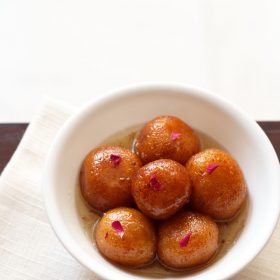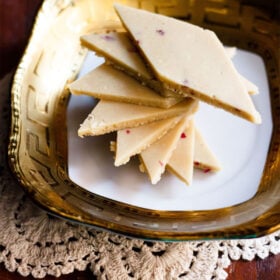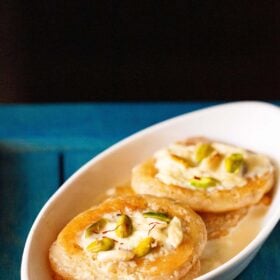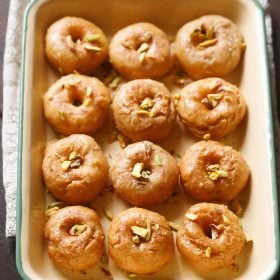
Cham Cham, also spelled as Chum Chum is one of the most classic sweets from Bengal. So, there, it can also be pronounced as Chom Chom. The word ‘chum’ also means a close friend. And that’s what this Cham Cham Sweet will be. Once you get to try it, you would definitely form a friendly bond with it! This sweet is easy to prepare, but does take some time and the procedure resembles that of making a rasgulla. This recipe demonstrates a stuffed variation. But you can relish it otherwise too.
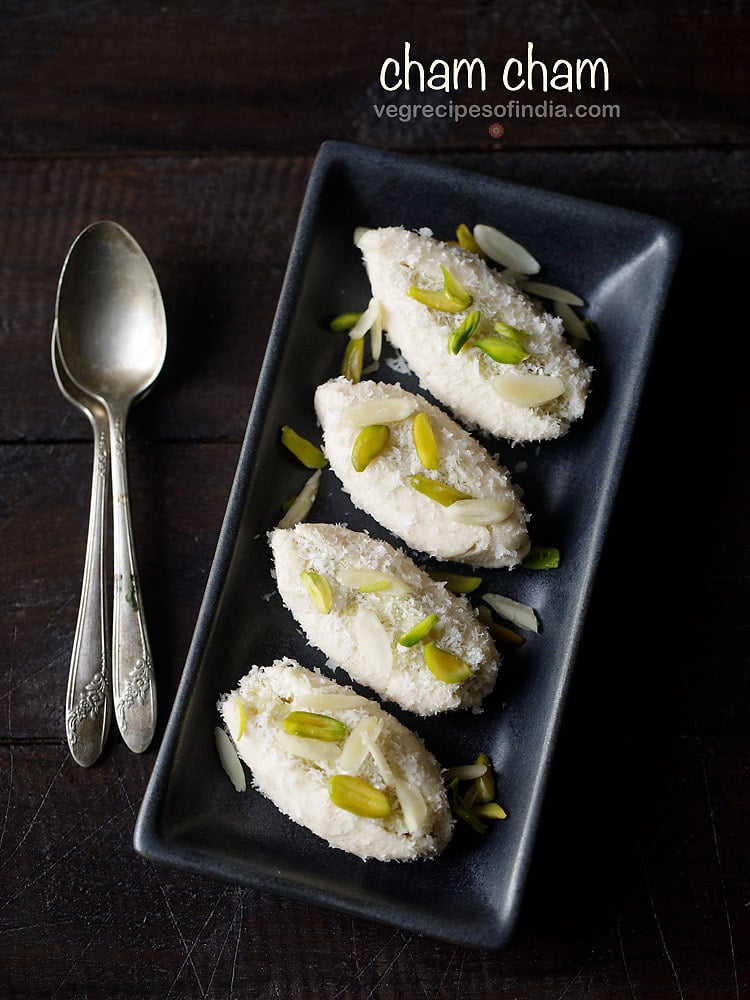

What is Cham Cham
As mentioned in the beginning, Cham Cham, popular locally as Chom Chom is another mishti (sweet) that Bengalis take pride in. And to be honest, it really is a fab one. Cham Cham Sweet technically is a milk-based preparation, with star ingredients being curdled milk (chhena), all-purpose flour and sugar.
Although, this sweet is primarily associated with West Bengal, but its origin is considered to be in Porabari in Tangail District of Bangladesh. This sweet is also not so ancient, as the history can be traced back to the mid-19th century. It is believed that the present-day Chum Chum was developed by a certain Matilal Gore from Ballia District, Uttar Pradesh in North India.
There are many Chom Chom variations that may be stuffed, like my recipe here or even plain flavored with essences, spice powders, etc. It is also not mandatory for this particular sweet to be simply white in color.
So, you may find others in shades of light yellow, light pink, light orange, etc. This mithai (sweet) may or may not be covered with coconut or even khoya, which usually forms the garnish. It is definitely the closest cousin of the other Bengali favorite, the rasgulla.
For this recipe, chhena (coagulated milk solids) is an integral ingredient, and is formed by curdling the milk. Then, you continue by kneading the chenna. Once done, you shape the mixture into oblong or cylindrical shaped pieces and cook them in a sugar syrup. This is typically how the formation of the Cham Cham Sweet is carried out.
In this Chum Chum recipe of mine, I have also made a sweet filling of milk powder, cream (malai) and sugar, and flavored it with saffron and cardamom powder. This really gives the Cham Cham, as extra edge and makes it even more decadent.
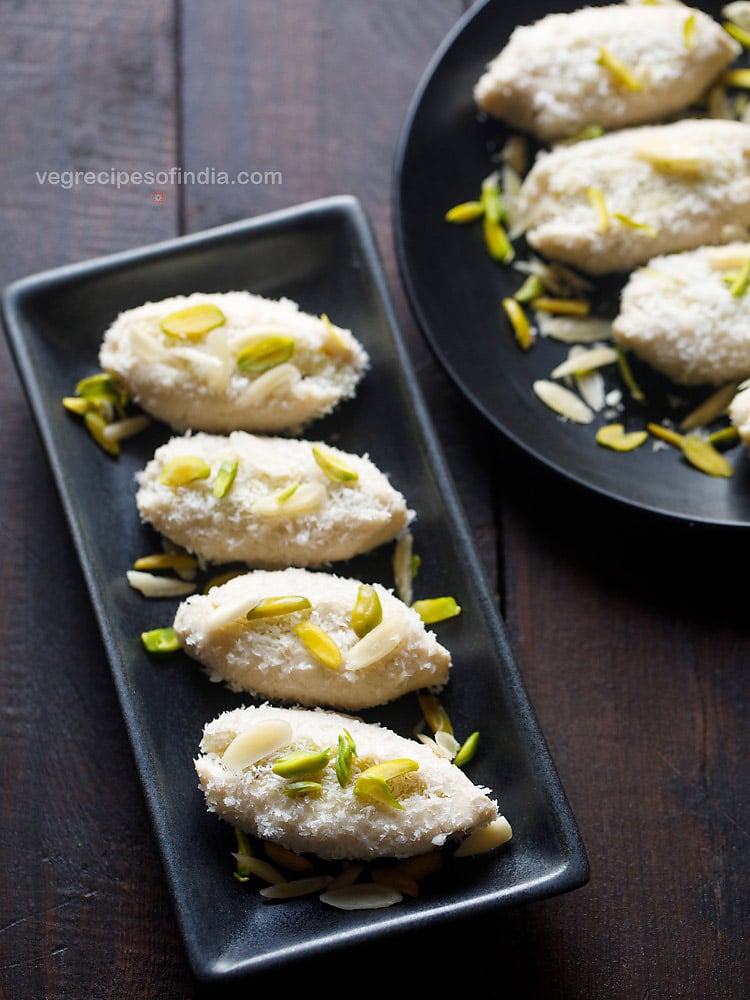

When sweets like Chom Chom or Rasgulla are prepared, what one looks for is sponginess, softness and smoothness in the texture. I am sharing some Frequently Asked Questions along with Tips that’ll surely help you to get the desired results in Chum Chum that you’re going to make in your home kitchen.
Step-by-Step Guide
How to make Cham Cham Sweet
Making chenna
1. Take 1 liter milk in a pan and let it boil on low to medium heat. When the milk begins to heat, stir at intervals.
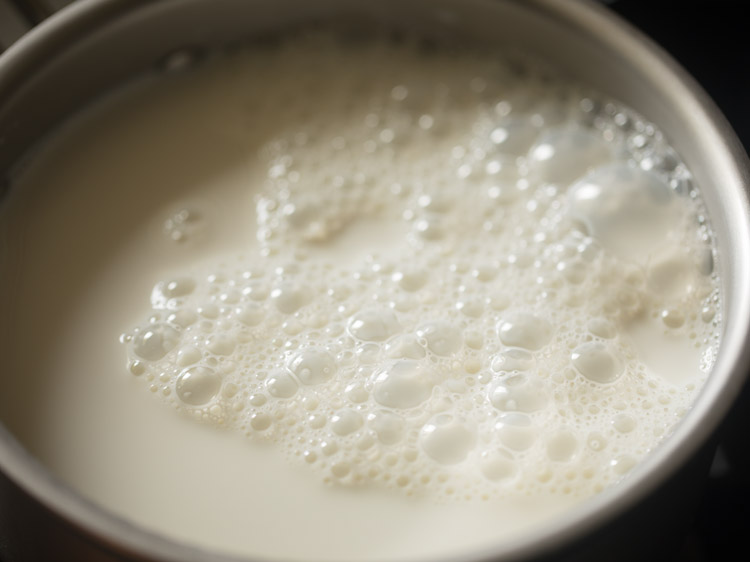

2. When the milk comes to a boil, you will see a layer of malai or clotted cream which forms on top. Remove this layer of malai. You will get about 2 to 3 tablespoons of malai. Keep this malai aside. We will be using this malai to make the sweet filling.
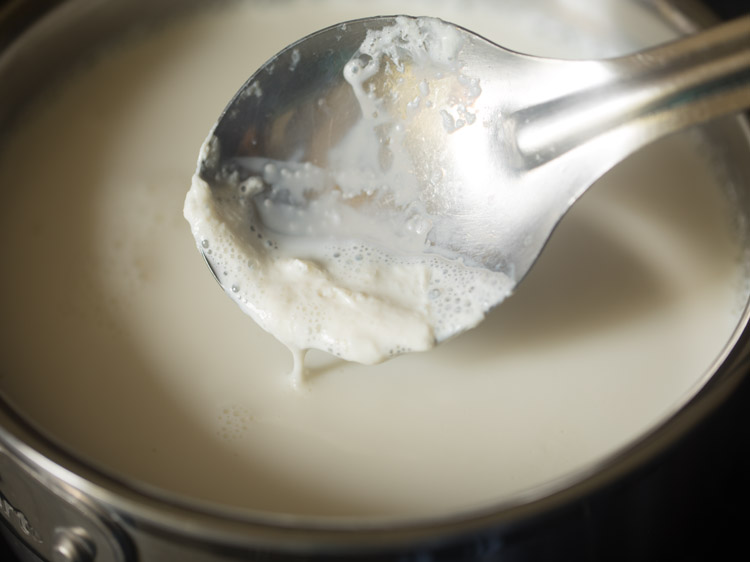

3. Let the milk come to a rolling boil, then switch off the heat.
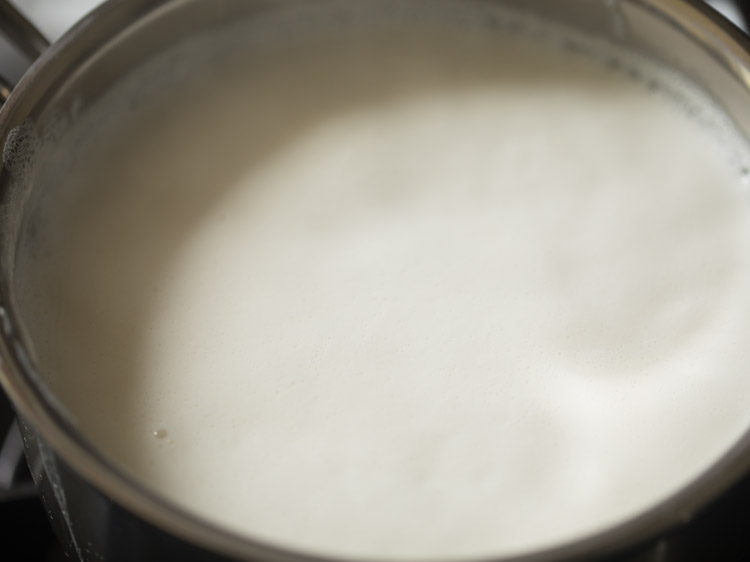

4. Add 2 tablespoons vinegar or lemon juice. You can even add 1 or 3 tablespoons vinegar or lemon juice. This quantity will depend on the quality of milk.
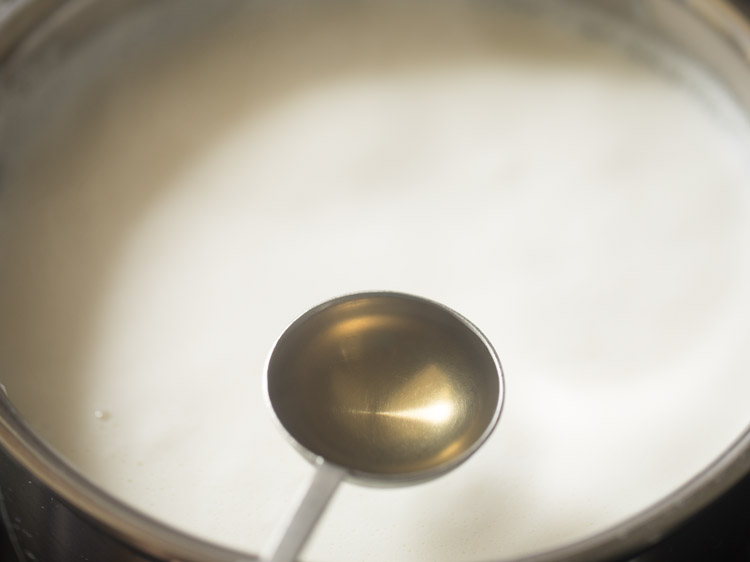

5. Mix very well and let the milk curdle.
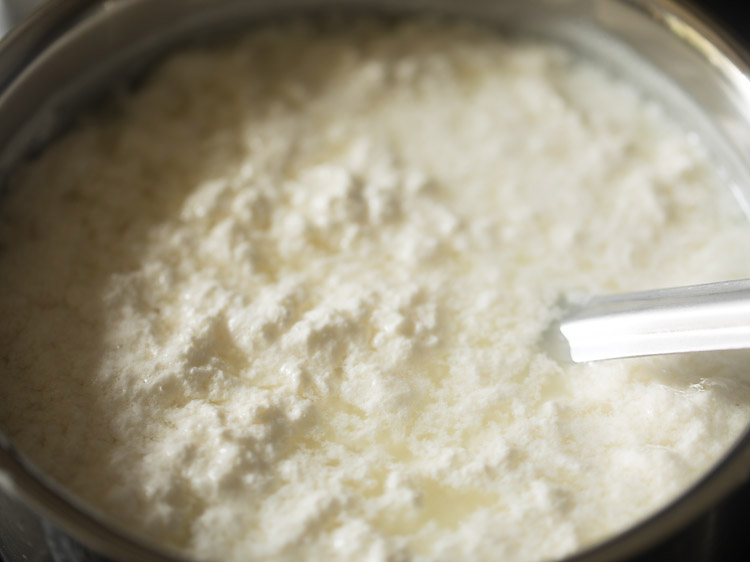

6. Wait for 4 to 5 minutes and let the heat reduce a bit. Then, strain through muslin lined on a top of a bowl or pan.
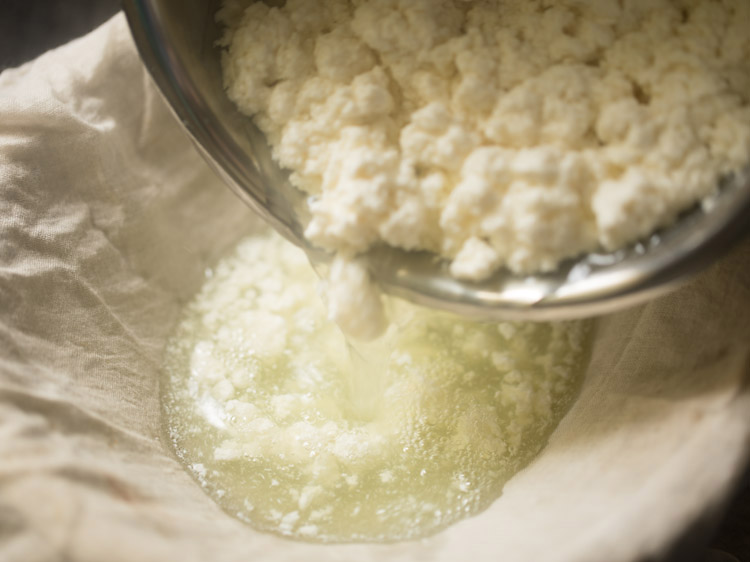

7. Bring the edges of the muslin together, straining all the whey. Be careful as both the chenna and whey will be hot.
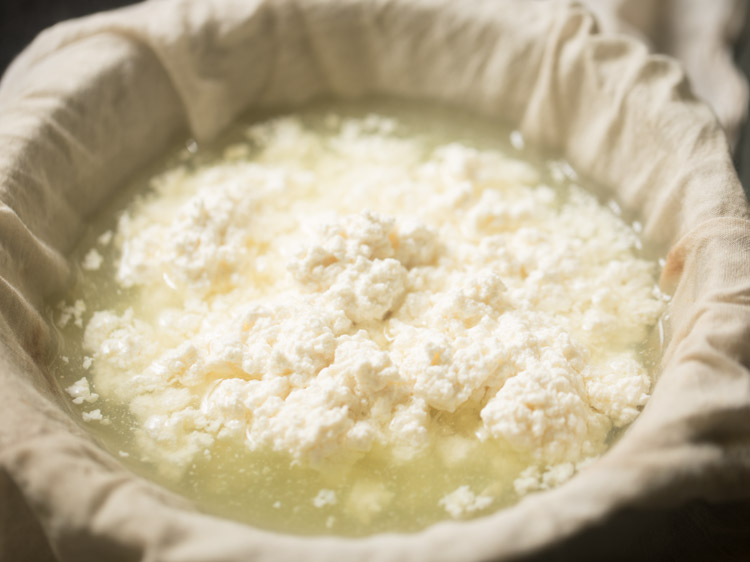

8. Rinse the chenna very well in running water. This will remove the tangy taste from the chenna. Then, gently squeeze the muslin to drain the excess water from the chenna. There should be no extra moisture in the chenna to avoid breakage of Cham Cham while cooking.
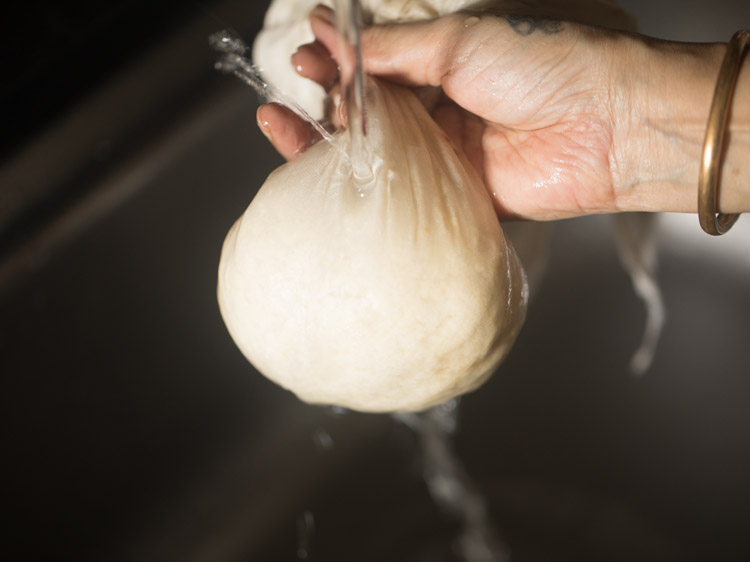

9. Keep a heavy weighted bowl or mortar-pestle on the chenna for 8 to 10 minutes.
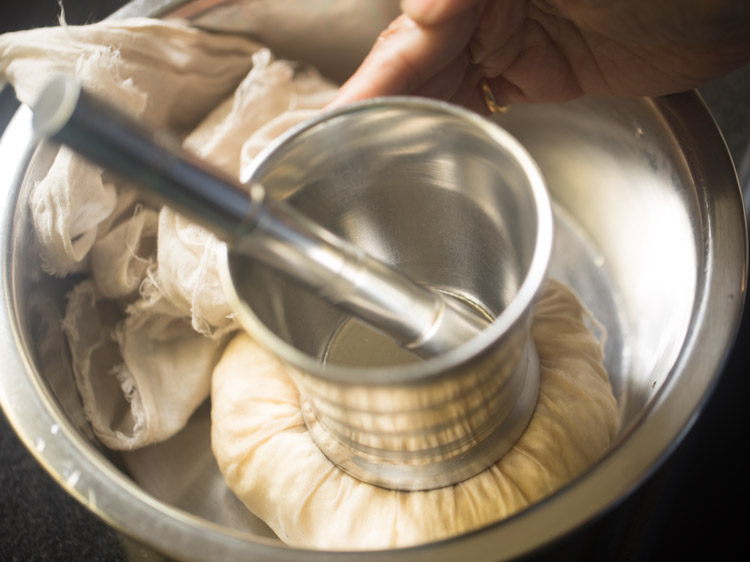

Kneading chenna
10. After 8 to 10 minutes, remove the chenna from the muslin. Place on a tray or a plate. Sprinkle 1 teaspoon all-purpose flour (maida). You can even add 1 teaspoon rava or cornstarch instead of maida.
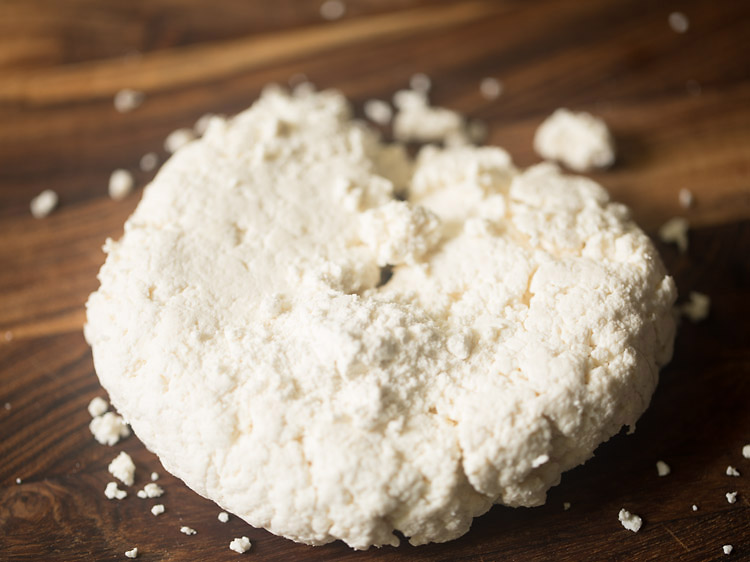

11. Mix and begin to knead the chenna. Mash and knead chenna with the heels of your palm. Also, keep on collecting the chenna from the sides and continue to mash and knead. Knead well, till your palms feel a bit of greasiness. Do not knead till the whole chenna becomes greasy.
If mixture looks dry and crumbly, sprinkle about 1 to 3 teaspoons water or more and continue to knead. The chenna mixture should be able to come together without breaking or falling apart. For a dry chenna, a bit of moisture helps in binding the mixture.
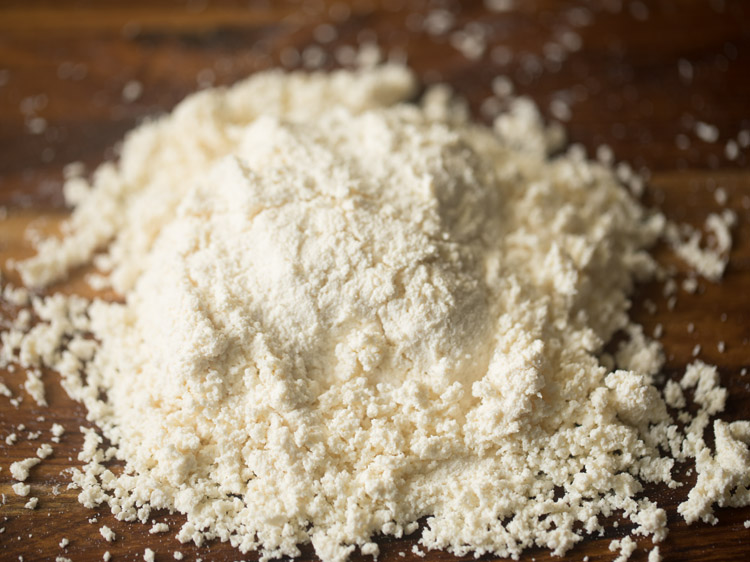

12. Knead chenna to a smooth large ball.
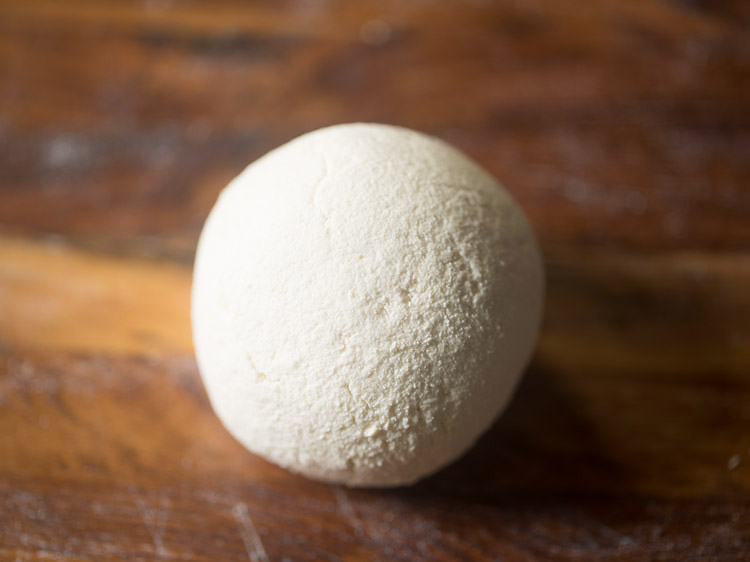

Shaping Cham Cham
13. Then, shape into a log and cut in equal pieces. You can even make small balls from the kneaded chenna.
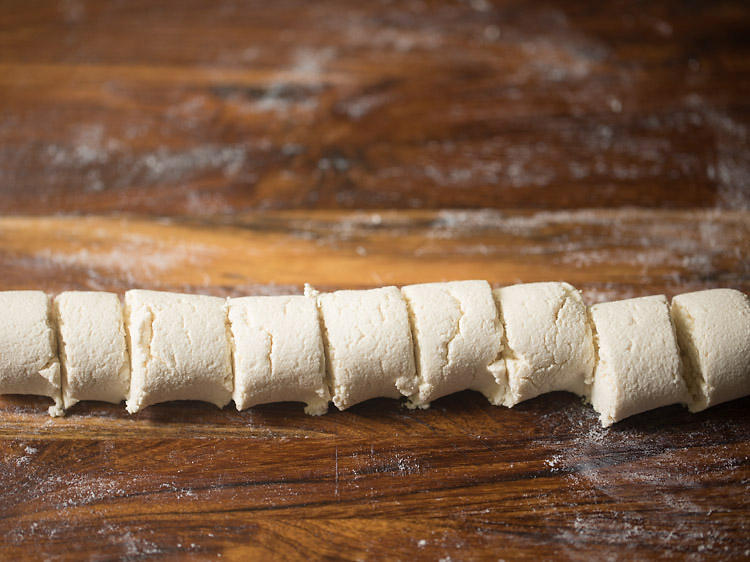

14. Take each piece and roll between your palms to a smooth cylindrical or oblong shape.
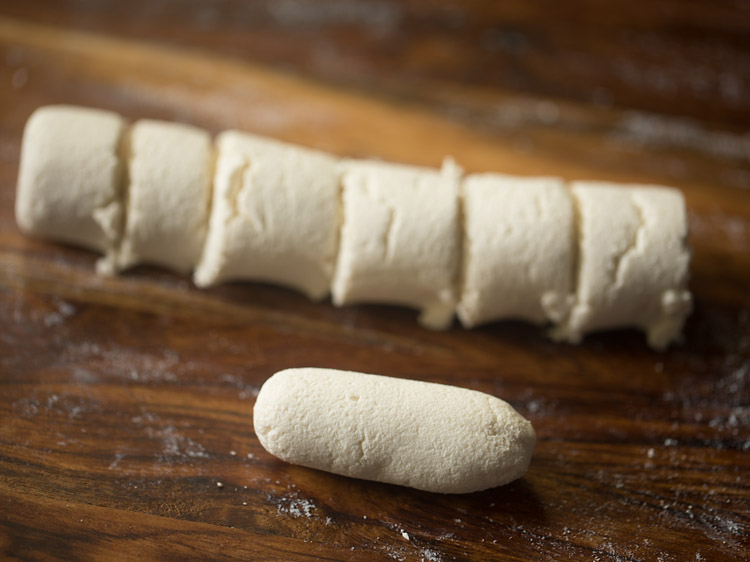

15. Pinch the edges.
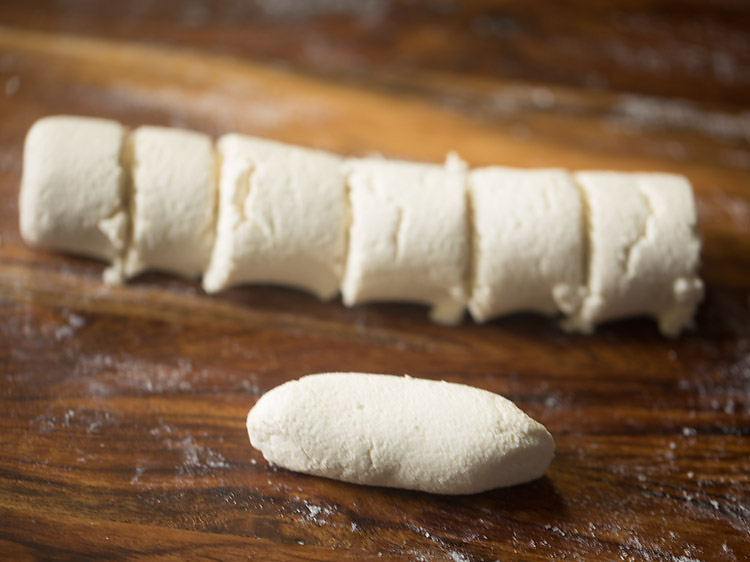

16. Make cylindrical shaped Chom Chom with all the pieces.
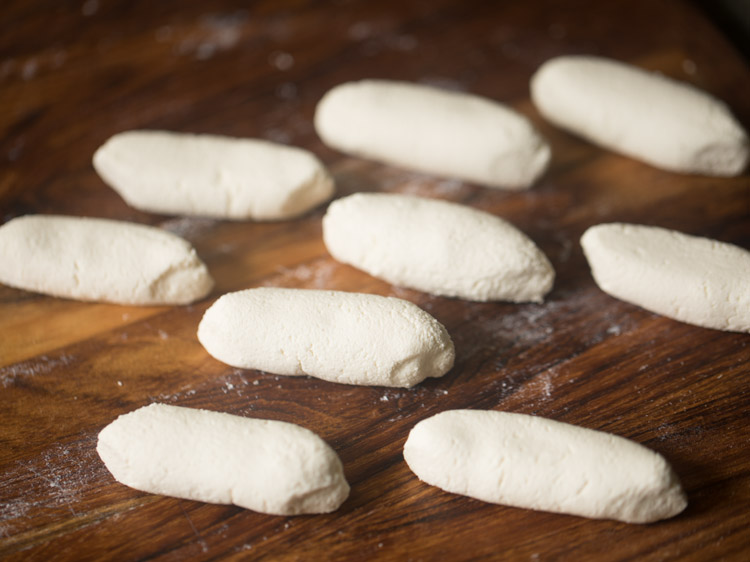

17. Keep them covered with a moist muslin cloth.
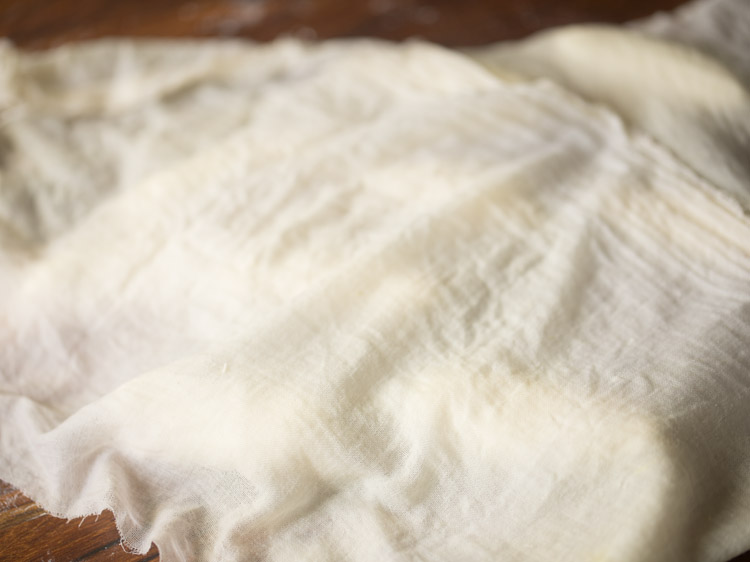

Making sugar syrup
18. Take 2 heaped cups (400 grams) sugar in a large pan. Use a large pot or pan with handles, so that there is enough space for the Chum Chum to cook and increase in size. I used a 3.4 liter stainless steel pan measuring 8.5 inches in diameter and 4.5 inches in height.
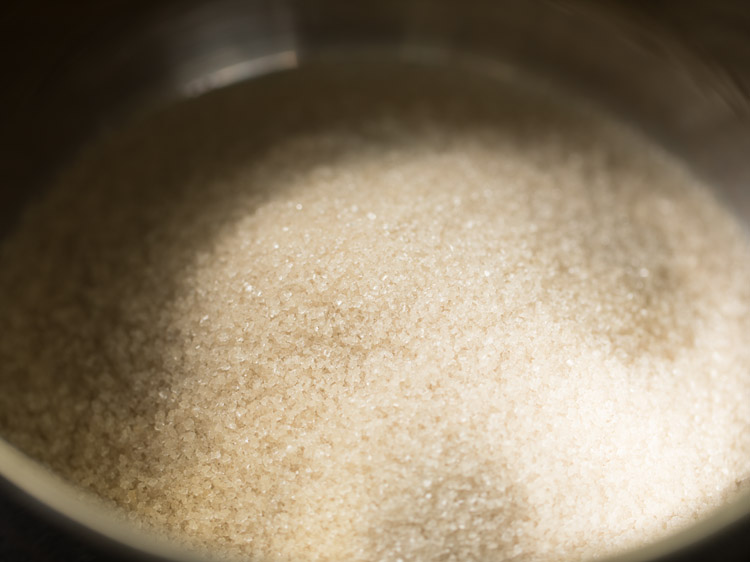

19. Pour 4 cups (1 liter) water in the pan.
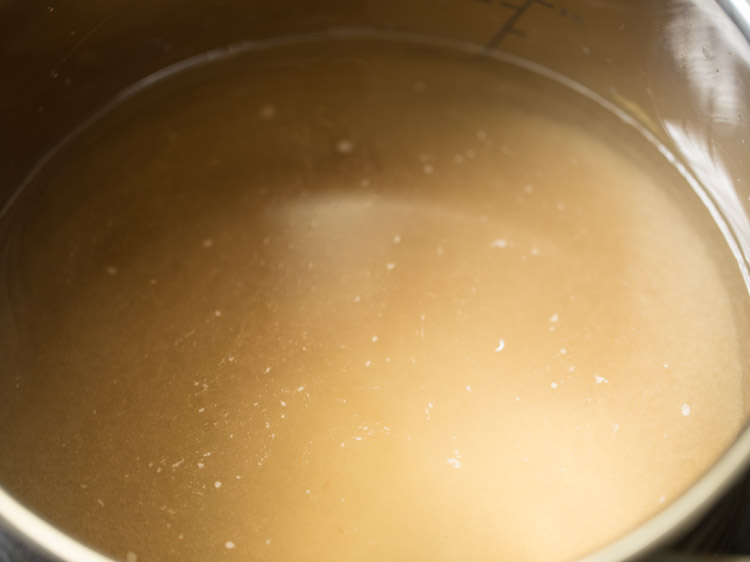

20. Place the pan on medium-low to medium heat. Stir non-stop with a spoon to dissolve the sugar completely.
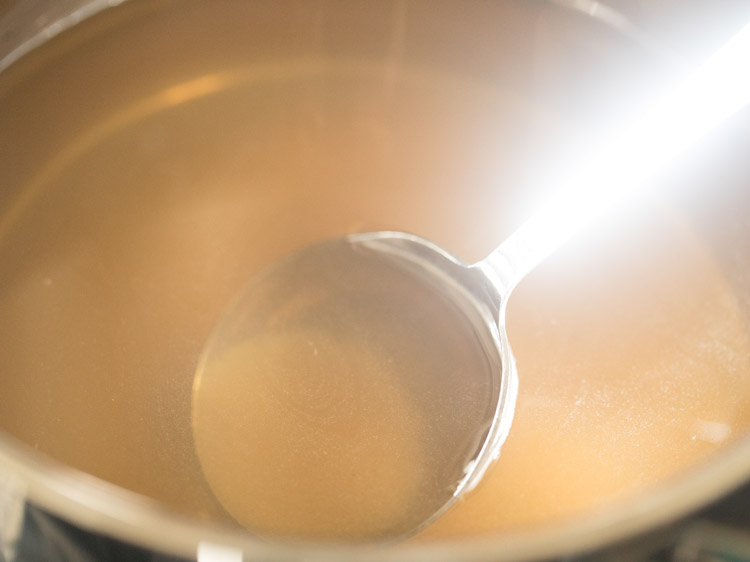

21. When the sugar dissolves completely, reserve 1 cup sugar solution. Keep it aside.
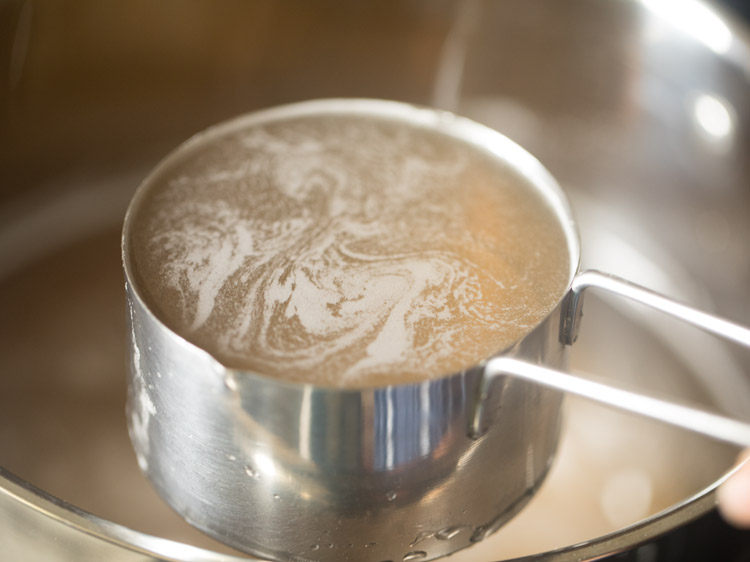

22. Then, let the sugar solution come to a boil on medium-high heat.
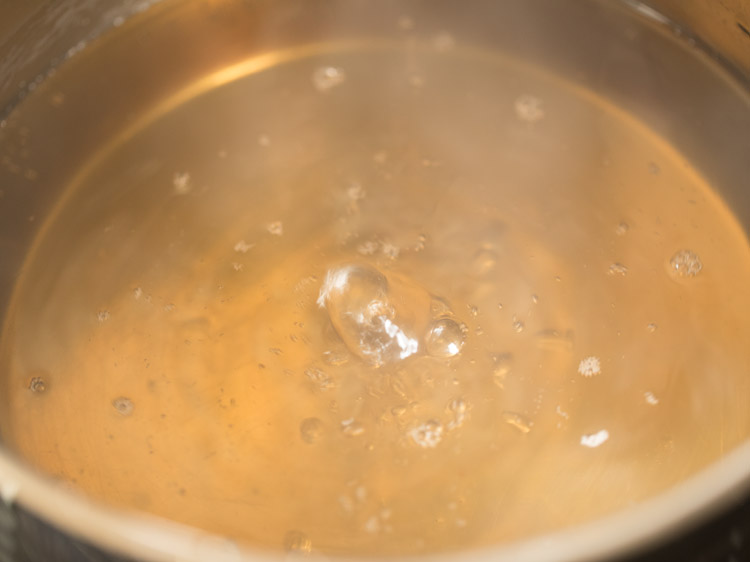

Cooking Cham Cham
23. When the sugar solution comes to a boil, then carefully place the Chum Chum pieces in it. Gently shake the pan holding the handles at the sides.
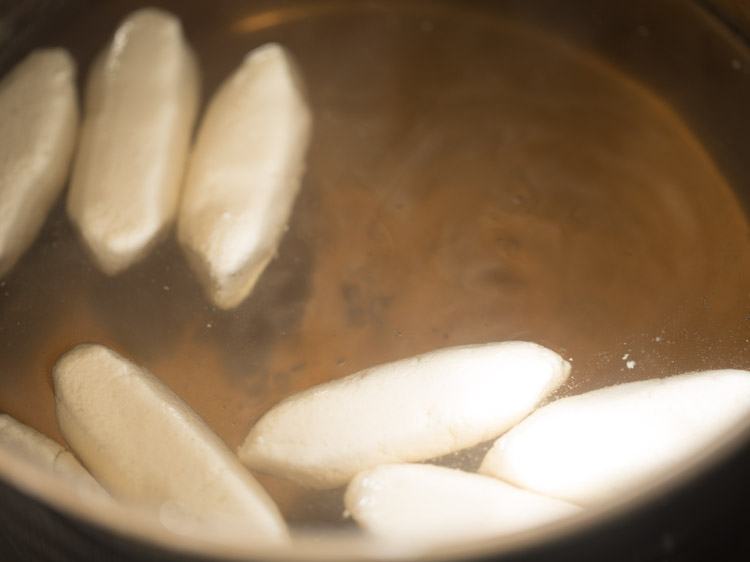

24. Cover the pan with a lid and boil Chom Chom on medium-high heat for 5 minutes.
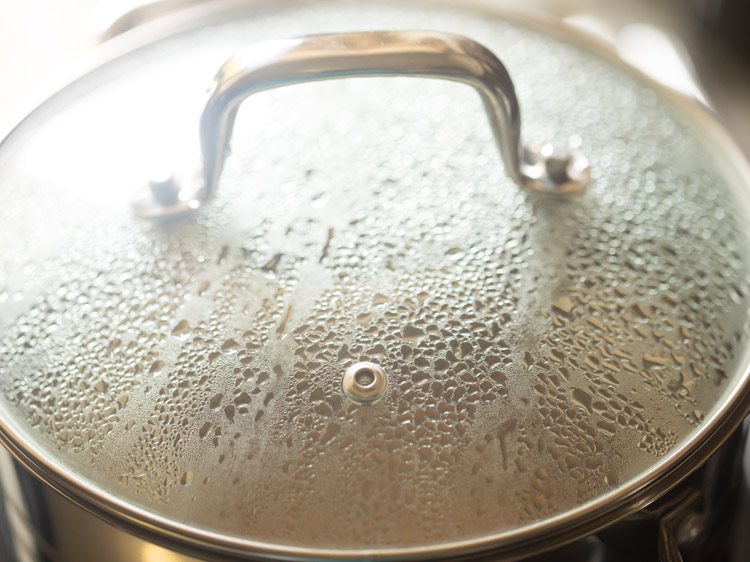

25. After 5 minutes, slowly add the reserved 1 cup sugar solution in a gentle stream.
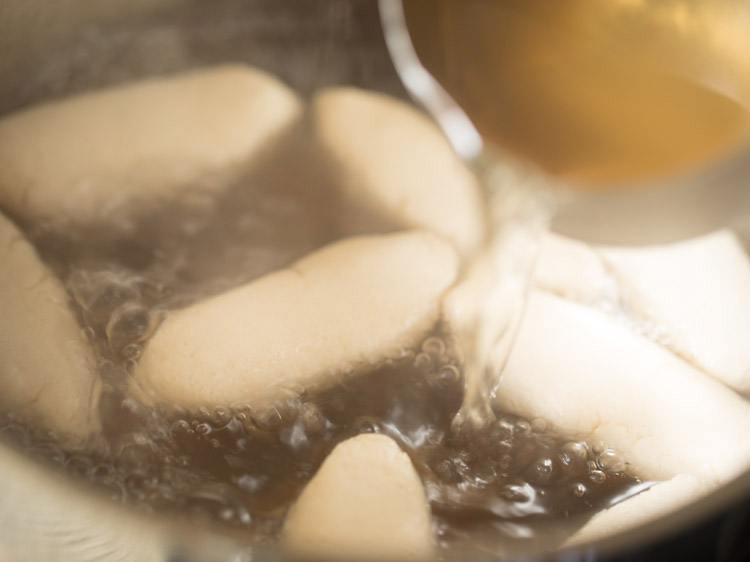

26. Hold the pan at the handles and gently shake it.
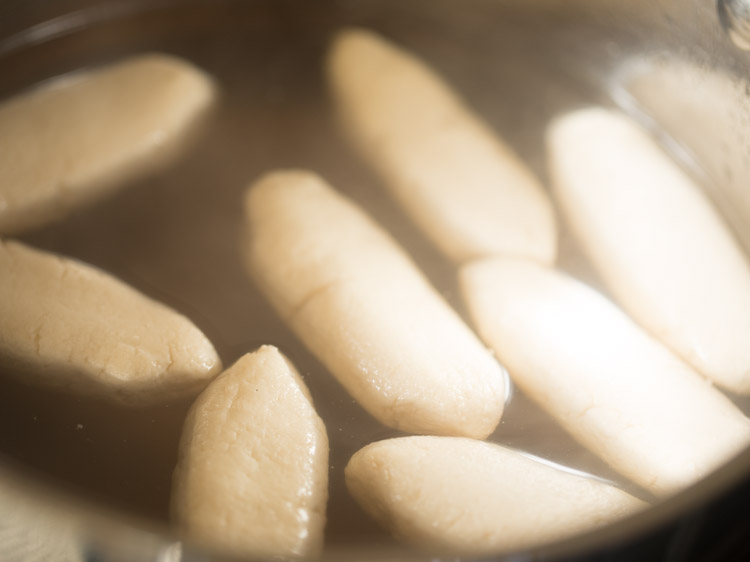

27. Cover again with the lid and cook for 7 minutes. I cooked for a total of 12 minutes. The cooking time will vary with the intensity of flame, pan type and size, etc. So, the total time taken for cooking can vary from 8 to 12 minutes. Do not overcook the Chom Chom pieces, as they become rubbery and dense.
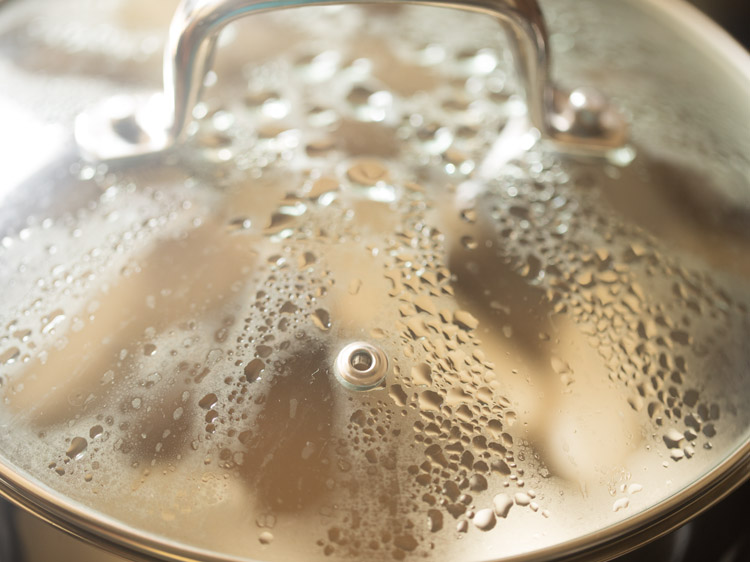

28. Check the doneness of the sweet after 8 to 10 minutes. For this, take one Chum Chum and place it in a bowl or mug of water. It should settle down at the bottom. If it is floating, you have to cook it for some more time.
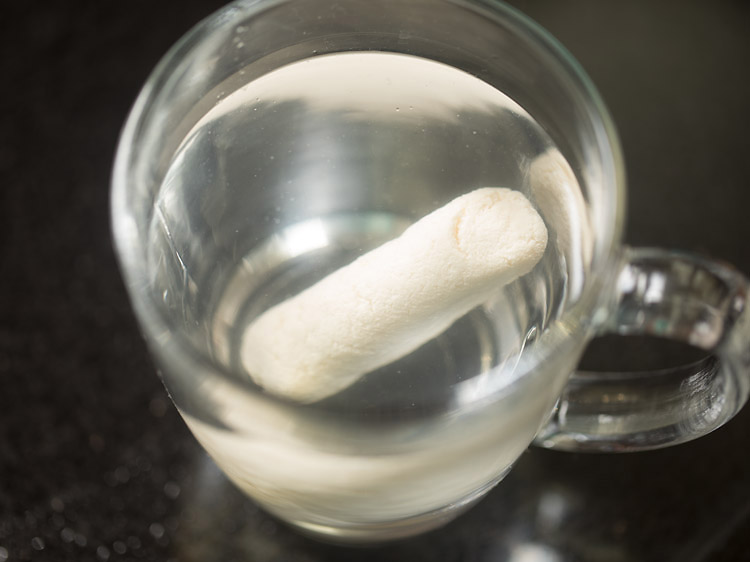

29. Once Chum Chum pieces are done, switch off heat. Remove the pan from heat and open the lid.
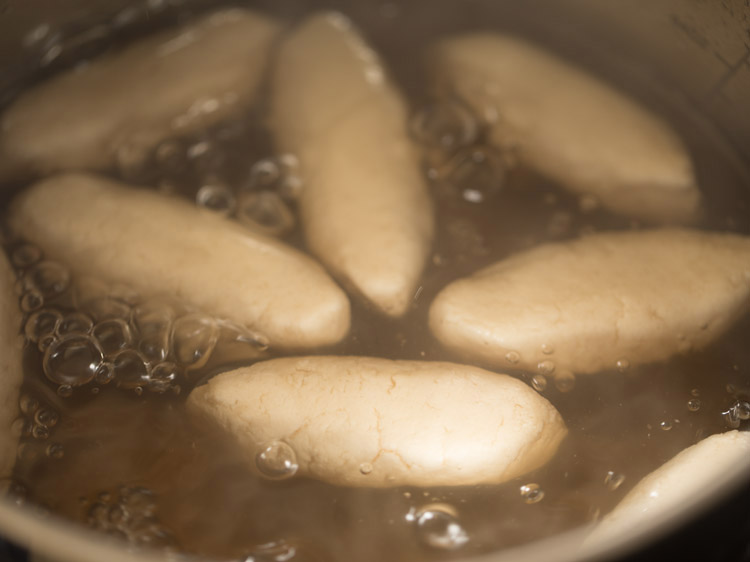

30. After 5 minutes, add 1 tablespoon kewra water or rose water. You can also add ½ to 1 teaspoon cardamom powder. Mix gently. Let Cham Cham cool completely.
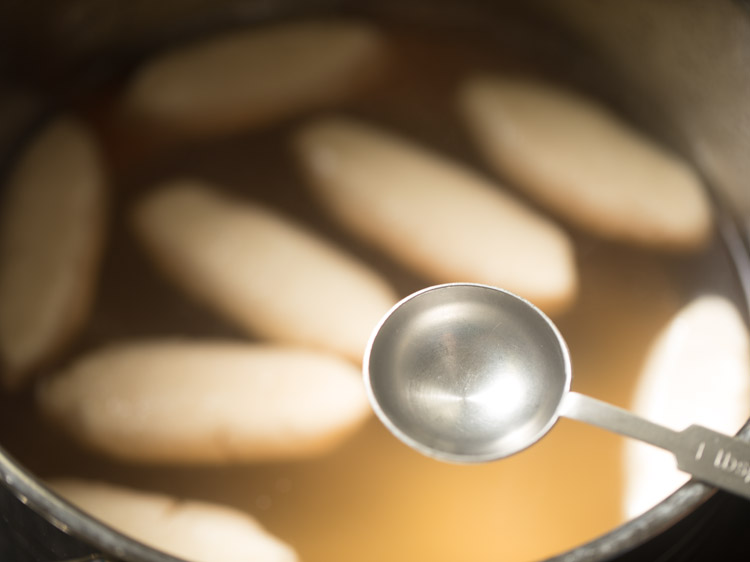

Making stuffing
30. In a heavy kadai or pan, take 6 tablespoons milk powder, 2 tablespoons sugar, 7 to 8 strands saffron and ¼ teaspoon cardamom powder.
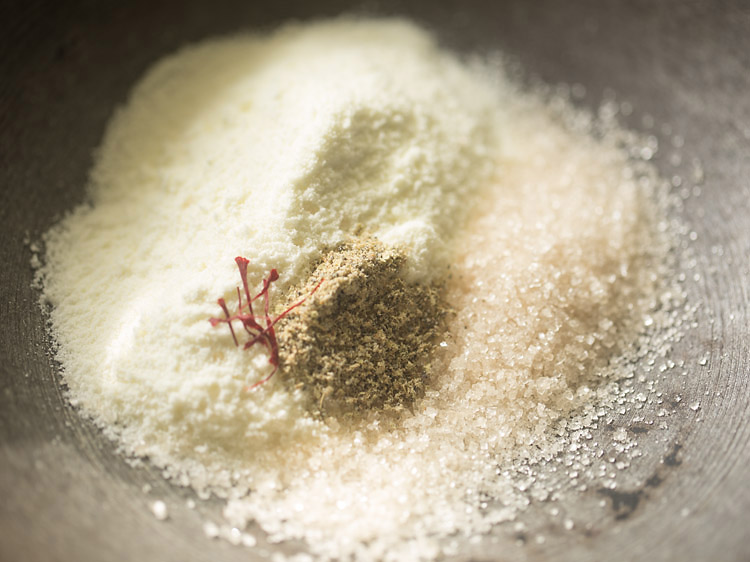

31. Next, add 2 tablespoons reserved malai or cream from the boiled milk. Also, add 2 to 3 tablespoons milk.
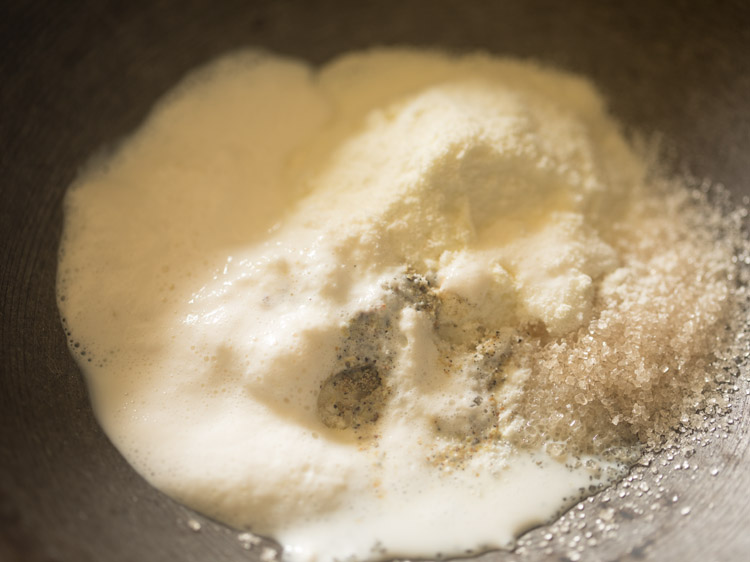

32. Mix everything and keep pan or kadai on low heat.
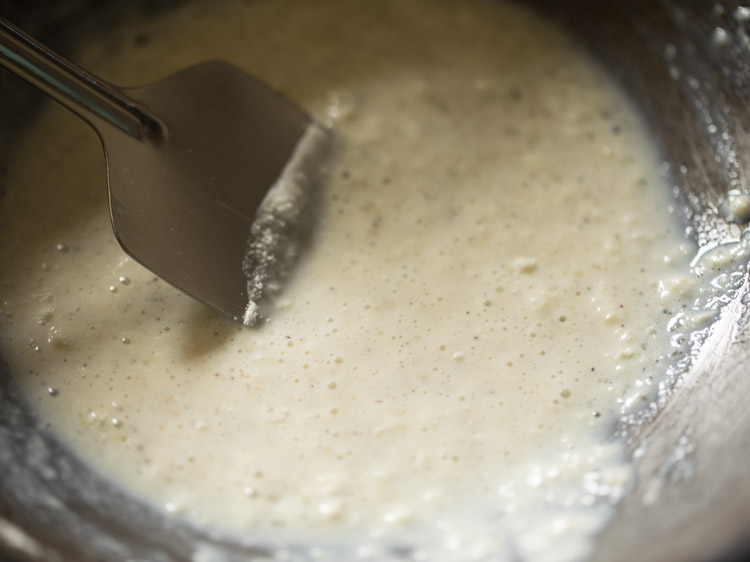

33. Stirring often, begin to cook this mixture.
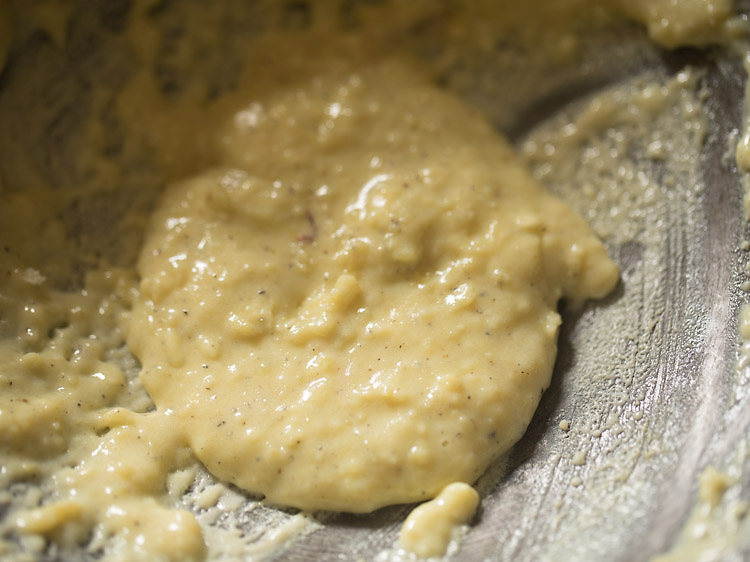

34. The mixture will begin to thicken. Stir continuously and cook till it leaves sides of the pan. Let this mixture cool completely. Again, do not overcook this mixture as then it becomes chewy and sticky. In case it becomes chewy and sticky, sprinkle some milk or water (1 to 2 tablespoons) on it and gently heat through.
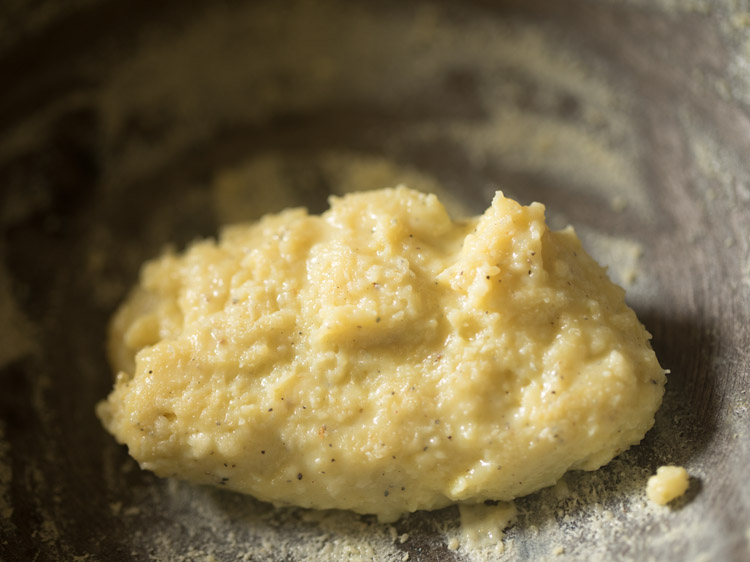

Stuffing Cham Cham
35. Place Cham Chams on a tray or board. With a knife, make a cut on top of each piece. Do not cut entirely.
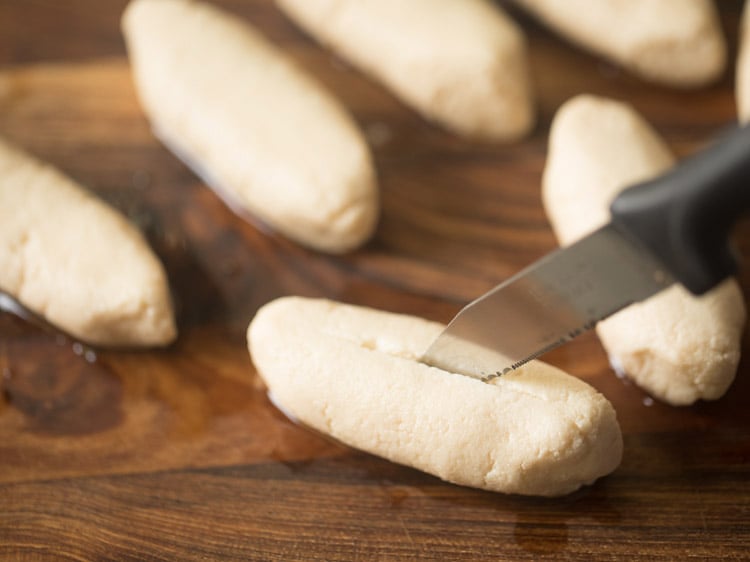

36. Pull apart the cut sides and place the stuffing in the Cham Cham carefully, without breaking them.
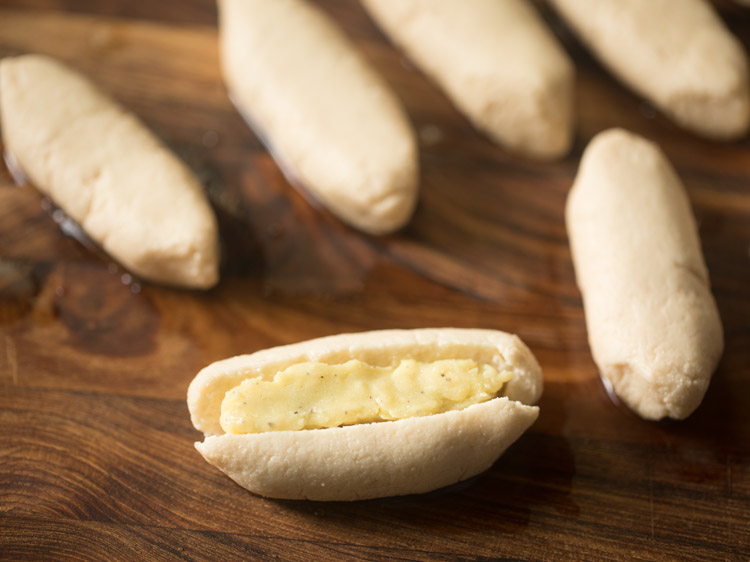

37. Stuff all the Chum Chum pieces this way.
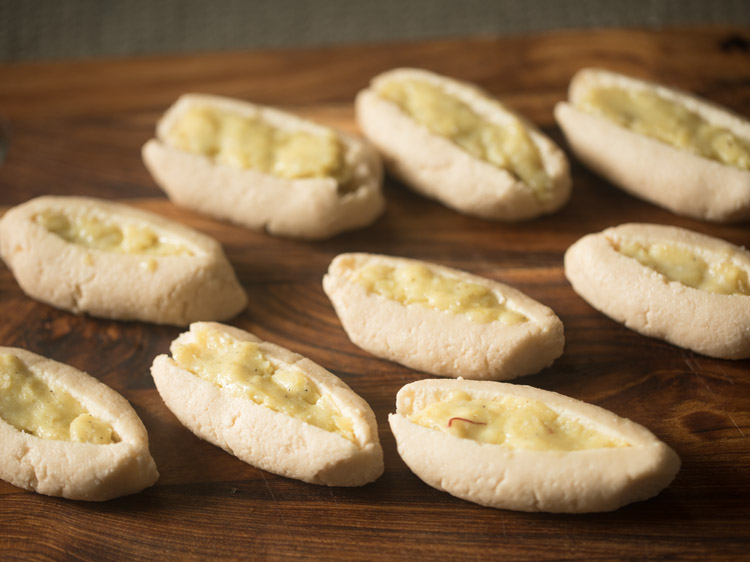

38. Take 2 to 3 tablespoons desiccated coconut in a plate and gently roll Cham Chams on it to coat them with the coconut.
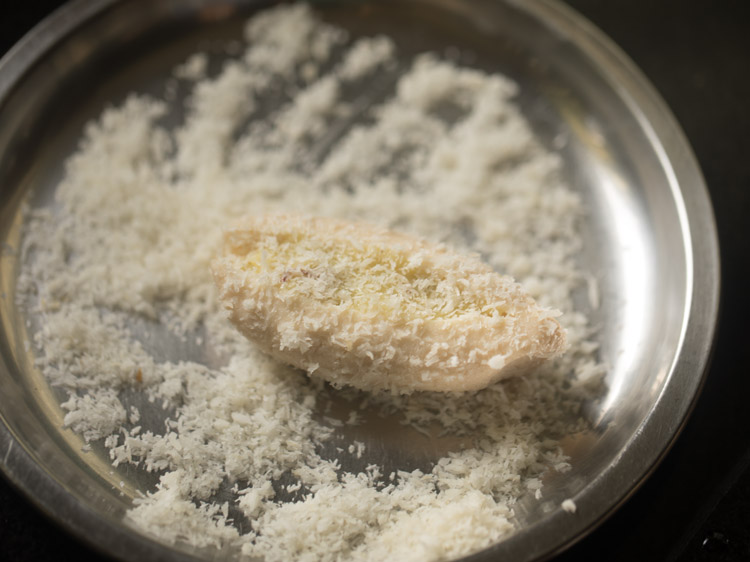

39. Do this with all the pieces.
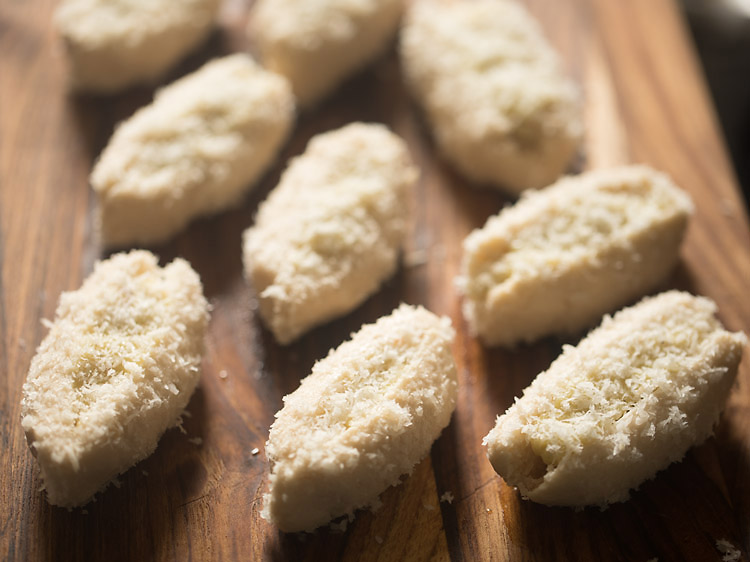

40. Place Cham Cham pieces on a serving plate or tray. Garnish with sliced pistachios and almonds.
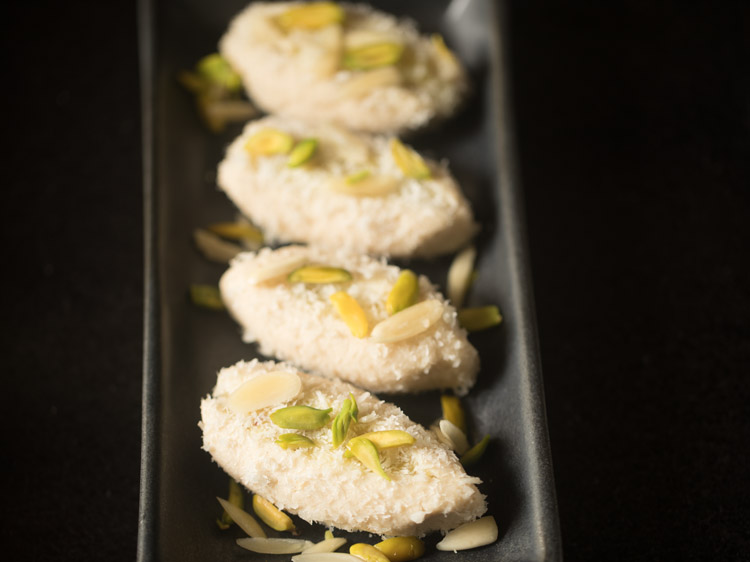

41. Serve Cham Cham at room temperature or chilled. Refrigerate any leftover pieces.
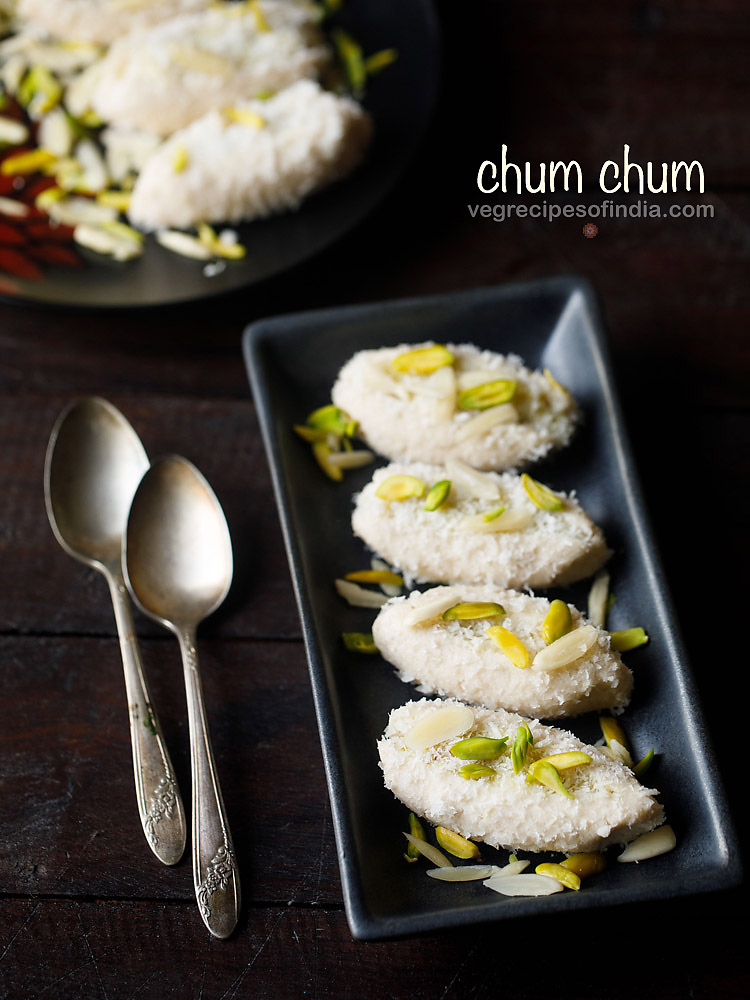

Expert Tips
- The malai or clotted cream from boiling the milk is used in making the sweet filling. So, reserve it and do not discard it.
- In order to curdle the milk to make chenna, add vinegar or lemon juice as per the quality of milk. So, it can be somewhere between 1 to 3 tablespoons, or even more.
- You must rinse the chenna very well under running water to get rid of the tangy taste in it. Also, make sure to gently squeeze the muslin, so that extra water is drained from the chenna. Remember, if there is excess moisture in the chenna, it will lead to the breaking of the Cham Cham while cooking.
- In place of all-purpose flour (maida), you can also use cornflour (cornstarch) or cream of wheat/semolina (rava/sooji).
- Rose water, kewra water or cardamom powder can be used to flavor the sugar syrup.
- You have to knead the chenna till the mixture comes together, without breaking or falling apart. If the mixture is dry and crumbly, sprinkle about 1 to 3 teaspoons water and knead. This moisture will help binding the mixture.
- The time to cook the Chom Chom pieces will depend on the type, size of pan and the intensity of flame. Make sure to not overcook them as then the sweet will turn out to be dense and rubbery.
- To check whether the Cham Cham Sweet is cooked or no: Take one piece and put it in a bowl/mug of water. If it is perfectly cooked, it will settle down at the bottom. If not, it will float.
- While making the stuffing, do not overcook the mixture or else it will turn sticky and chewy. In case it does, just add about 1 to 2 tablespoons of milk/water and gently heat through.
- Having or scaling of this recipe is possible. So, make accordingly.
FAQs
While making chenna based sweets like Cham Cham, rasgulla or sandesh, always use whole full-fat milk. You can even use pasteurized milk. Also, make sure that the milk is fresh and is in its shelf period. Toned or skimmed milk should be avoided.
The correct balance of moisture is very crucial to get the right texture in this sweet. If there is too much water or moisture in the chenna, the pieces will break or disintegrate while cooking. Too less moisture, the pieces will become dense, shrink or flatten after cooking and cooling. This moisture content can be checked when you are kneading the chenna.
While kneading, if you see that it is too moist or watery, it means there is more water. Add a bit more of all-purpose flour/maida so that it absorbs the extra moisture. You can keep a heavy weight on the chenna so that some of the water or whey reduces. While kneading, if you see that it is dry and crumbly, there is less moisture. Sprinkle 1 to 2 teaspoons water to make the chenna slightly moist. The moisture helps in binding and makes the pieces soft. However, at the same time, there should not be too much of moisture or water in the chenna.
The pressure and force of your palms, with which you knead the chenna, will decide the time taken to knead it. However, as a benchmark, stop kneading when your palms become a bit greasy. While kneading, some fat from the chenna is released. So, your palms must become a bit greasy during the kneading process. At this step, stop kneading and shape chenna into Chom Chom. Knead chenna to a smooth large ball and it should be able to come together without breaking or falling apart.
The sugar syrup for this specific sweet does not have any string consistency like 1 string, 2 strings, etc. It’s a watery sugar syrup. Since it is watery, the mithai absorbs the sugar syrup and tastes sweet.
When cooking Chum Chum, always use a large pan, enough to accommodate all the sweet pieces that will expand while cooking. Do not stir with a spoon or ladle as the pieces can break. It’s better to use a pan with handles, so that you can shake and swirl the pan gently, by holding the handles. If the chenna is dry, then also the sweet can get shrunk or flattened.
Firstly, the Cham Cham will expand in size while cooking. Overall, the cooking time varies from 8 to 12 minutes. The time variations are due to the size of the sweet pieces, the quality and type of pan, flame intensity, etc. So, after 8 to 10 minutes, you can remove a piece and place it in a mug or bowl of water. If the sweet settles at the bottom, it’s cooked. If it floats, it’s undercooked.
If the Chom Chom pieces are cooked too much, they will end up becoming dense and rubbery. So, don’t overcook them.
Of course, you can. Colored Cham Chams are appealing to kids as well. If using any coloring ingredient, I would suggest to use natural color extract. So, add the natural color extract in the chenna while kneading. You can divide the chenna in 2 or 3 portions to get 2 to 3 colored varieties of the sweet.
No, making the sweet filling is not essential. You can skip it completely. Also rolling Chum Chum in desiccated coconut is optional and can be skipped.
More Sweet Recipes To Try!
Sweets Recipes
Sweets Recipes
Sweets Recipes
Sweets Recipes
Please be sure to rate the recipe in the recipe card or leave a comment below if you have made it. For more vegetarian inspirations, Sign Up for my emails or follow me on Instagram, Youtube, Facebook, Pinterest or Twitter.
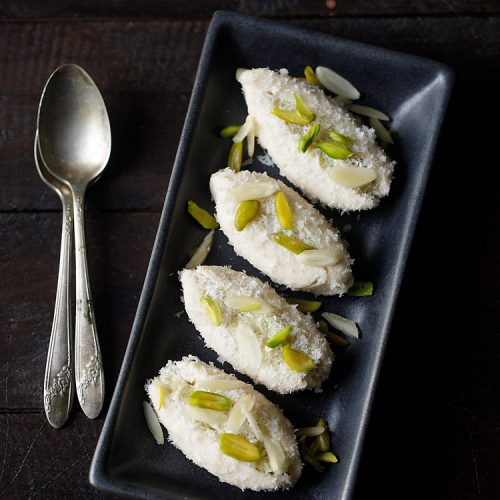

Cham Cham Sweet Recipe | Bengali Chum Chum Recipe
Cham cham is a popular sweet from bengal made by curdling milk. Cham is also called as chum chum. This recipe will help you in making spongy & soft cham cham since a lot of tips and suggestions are included in the recipe post.
Prep Time 28 minutes
Cook Time 12 minutes
Total Time 40 minutes
Prevent your screen from going dark while making the recipe
making chenna
Begin to heat 1 litre milk in a thick bottomed pan. Stir at intervals when the milk begins to get heated.
When the milk comes to a boil, you will see a layer of malai or clotted cream which forms on top. Remove this layer of malai. You will get about 2 to 3 tablespoons of malai. We will be using this malai to make the sweet filling for cham cham.
Switch off flame when milk comes to rolling boil.
Add 2 tablespoons vinegar or lemon juice. You can even add 1 tablespoon vinegar or lemon juice. The amount to be added will depend on the quality of milk.
Mix very well and let milk curdle.
Wait for 4 to 5 mins and let the heat reduce a bit. Then strain through muslin lined on a top of a bowl or pan.
Bring the edges of the muslin together, straining all the whey. Be careful as both the chenna and whey will be hot.
Rinse the chenna very well in running water. This removes the lemony flavor and tangy taste from the chenna. Then gently queeze the muslin with your hands, so that any extra water is drained from the chenna.
Keep a heavy weighted bowl or mortar-pestle on the chenna for 8 to 10 minutes.
kneading chenna
After 8 to 10 minutes remove the chenna from the muslin. Place on a tray or a plate. Sprinkle 1 teaspoon maida or all purpose flour. You can even add 1 teaspoon rava (sooji) or corn flour instead of maida.
Mix and begin to knead this mixture. Knead very well till some greasiness is felt in your palms. Just a bit of greasiness is required. Knead to a smooth ball of chenna. If mixture looks dry and crumby sprinkle some water – about 1 to 3 teaspoons or more and continue to knead. The mixture should be able to come together without breaking or falling apart. For a dry chenna a bit of moisture helps in binding the mixture.
Then roll the chenna ball into a log. cut in equal pieces.
Take each piece and roll them between your palms to a smooth cylindrical or oblong shape. pinch the edges.
Make oblong shaped cham cham with the entire kneaded chenna. keep them covered with a moist muslin cloth.
making sugar syrup for chum chum
Take 2 heaped cups sugar (400 grams) in a large pan. Please use a large pot or pan so that there is enough space for the cham cham to cook and increase in size.
Pour 4 cups water (1 litre) in the pan.
Place the pan on a medium-low to medium flame. With a spoon stir non-stop and mix so that all the sugar is dissolved.
When all the sugar is dissolved, remove 1 cup of sugar solution and keep it aside. let the sugar solution come to a boil on a medium-high flame.
cooking chom chom
When the sugar solution starts boiling, carefully place the chum chum in the sugar solution. Gently shake the pan holding the handles at the sides.
Cover the pan with lid and boil chum chum on medium-high flame for 5 minutes.
After 5 minutes in a gentle stream, slowly add the 1 cup of reserved sugar solution. hold the pan at the handles and gently shake it.
Cover again with lid and cook covered for 7 minutes. I cooked for a total of 12 minutes. The cooking time will vary with the intensity of flame, pan type and size etc.
To check if the cham cham has cooked, take one piece and place it in a bowl or mug of water. It should settle down at the bottom. If it floats then the cham cham needs to be cooked for a few more minutes.
Once the chum chum are cooked, switch off flame. Keep the pan down and remove the lid.
After five minutes add 1 tablespoon kewra water or rose water. You can also add ½ to 1 teaspoon cardamom powder. Shake the pan gently. Let cham cham cool completely.
making stuffing for chum chum
In a heavy kadai or pan, take 6 tablespoons milk powder, 2 tablespoons sugar, 7 to 8 strands saffron and ¼ teaspoon cardamom powder.
Next add 2 tablespoons malai or cream reserved from the milk when we had boiled it. Also add 2 to 3 tablespoons milk.
Mix everything and keep pan or kadai on a low flame.
Stirring often begin to cook this mixture.
The mixture will begin to thicken. Stir continuously and cook till the mixture leaves sides of pan. Let this mixture cool completely.
making chum chum
Place them on a tray and board. With a knife make cut each cham cham on top. Do not cut the cham cham entirely.
Place the stuffing in the cham cham sweet carefully without breaking them.
Stuff all the pieces this way.
Take desiccated coconut in a plate and gently roll cham cham sweet so that the desiccated coconut sticks to the cham cham.
Do this with all the cham cham pieces.
Place them on a serving plate or tray. Garnish with sliced pistachios and almonds.
Serve cham cham. Or you can chill them and then serve later. Refrigerate any leftover pieces.
This cham cham recipe can be easily halved or doubled.
Nutrition Facts
Cham Cham Sweet Recipe | Bengali Chum Chum Recipe
Amount Per Serving
Calories 62 Calories from Fat 27
% Daily Value*
Fat 3g5%
Saturated Fat 1g6%
Cholesterol 9mg3%
Sodium 27mg1%
Potassium 86mg2%
Carbohydrates 5g2%
Sugar 5g6%
Protein 1g2%
Vitamin A 95IU2%
Vitamin C 0.4mg0%
Calcium 57mg6%
Iron 0.1mg1%
* Percent Daily Values are based on a 2000 calorie diet.
This Cham Cham Sweet Recipe from the archives was first published in February 2018. It has been updated and republished in March 2024.

Source link
